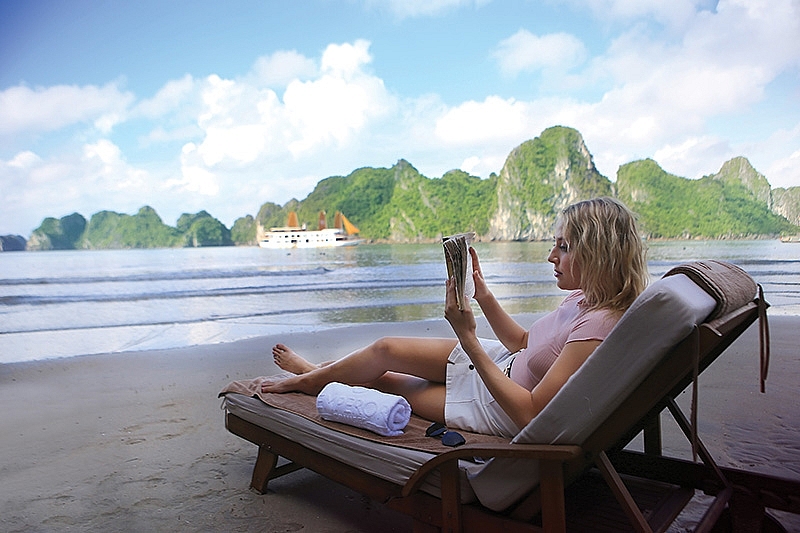
Vietnamese resorts need more than natural scenery to lure in cosmopolitan tourists.
Alhough the demand remains strong, the hospitality and second-home markets are still held back by a series of issues, preventing them from truly blossoming.
Troubles include the monotonous programmes which cannot keep tourists in Vietnam for longer visits and the low number of visitors returning to Vietnam.
“The sun, sea, and sand are not enough, Vietnamese tourism firms need to create more unique products and come up with novel experiences to compete with other holiday hotpots and keep tourists longer,” said Ha Van Sieu, deputy general director of the Vietnam National Administration of Tourism (VNAT). “Especially with Industry 4.0 taking over all sectors, local tourism needs to react to the demand for innovative offerings.”
With more than 22 years of experience in the Vietnamese tourism and hospitality scene, Kai Marcus Schröter, general director for Hospitality Tourism Management (HTM), agreed with Sieu, adding that plans for tourism development are still not synchronised, while tourism products are still far from new and unique.
He said that there are a great many tasks in front of the Vietnamese tourism industry to improve its competitiveness, highlighting ineffective promotions and the incomplete infrastructure system, adding that policies for foreign tourists, especially those related to visa issuance, need to be more open.
Moreover, the industry needs to refresh itself to meet the changing requirements of the global market.
“I have had the opportunity to participate in many investment seminars in Vietnam. Here, many projects call for investment, including casinos, racetracks, sports complexes, and so on. I believe that calling for new projects is good, but Vietnam needs to consider their feasibility in light of the new circumstances,” said Schröter.
Meanwhile, Adam Bury, senior vice president, Investment Sales Asia at JLL’s Hotels & Hospitality Group, said that Vietnam remains behind Thailand in tourism development, even though its advantages far exceed it.
Bury said that Thailand has three airports and hotspots [Bangkok, Phuket, and Kohsamui], while Vietnam has far more, like Hanoi, Ho Chi Minh City, Nha Trang, Phu Quoc, and Danang. However, in 2018, Vietnam welcomed 15 million tourists, while Thailand welcomed 38 million.
Bury highlighted limitations in visa extension and the lack of infrastructure. “Vietnam has invested in many new airports, however, it has many things to do to improve the services at these airports to attract tourists back for the second time,” Burry explained.
New, trendy experiences
Creating new experiences, products, and services are key areas of interest for second home and hospitality developers in a market that is growing more competitive by the day.
Developers are beginning to propose international mid-scale and focused service hotels, as well as giving priority to design and guest experience.
According to Mauro Gasparotti, director of Savills Hotels APAC, well-positioned hotels or resorts with ‘instagrammable’ design, quality F&B, unique facilities or services perform better with higher rates and occupancies than more standard products.
“We would love to see more of them as, along with the guest experience, they also increase the quality of the destination,” said Gasparotti.
Hotels now have possibility to clearly identify categories of travellers to serve their needs in a much more personal way than before. The consumer behaviour changes are due to new technologies and data analytics which have increased growth in solo travellers, experience seekers, groupies, Instagrammers, adventure seekers, last minute travellers, single parents, multigenerational families, as well as b-leisure and wellness travellers.
According to Bryan Chan, director of development, Southeast Asia & Korea of InterContinental Hotels Group (IHG), technology has permeated the entire spectrum of the IHG hotel experience from the initial property design to delivering on the brand promise every day.
“With constant innovation, the key is to pick the best technology to support owners, making things easier for colleagues, as well as lighting up the guest experience,” Chan said.
Guests can now use technology to facilitate their journey before, during, and after staying at the hotel. Energy and waste reduction technologies are expected to save costs by monitoring the ongoing performance of equipment in the building. Modular construction is considered an innovative methodology for fast and efficient construction with consistent quality.
Meanwhile, robot butlers, mobile keys, mobile check-in/check-out or smart guestrooms are being adopted more often in hotels to reduce operating costs and staff.
High-potential market
According to the General Statistics Office, in the first quarter of 2019 Vietnam welcomed more than 4.5 million international visitors, an increase of 7 per cent compared to the same period of 2018. The majority of tourists are coming from Asia, Europe, and the US.
“There is a wave of both foreign and domestic investors and developers rushing to get a piece of the market,” Sieu said, adding that the Vietnamese tourism industry is exceeding all targets. Previously, Vietnam planned to receive around 10 million visitors in 2020, which it reached in 2016. Similarly, the 2025 target was reached in 2018, and the 2030 target is expected to be reached this year – more than 10 years early.
According to Mauro Gasparotti, Vietnam still has one of the highest growth rates in the world in terms of international arrivals, new international brands, and project pipeline.
“The hospitality industry will continue to contribute greatly to the rapid growth of the economy and create more jobs. The market has witnessed an increase in hotel and resort rates throughout the country, with the performance of hotels in main cities being particularly strong,” Gasparotti said.

















